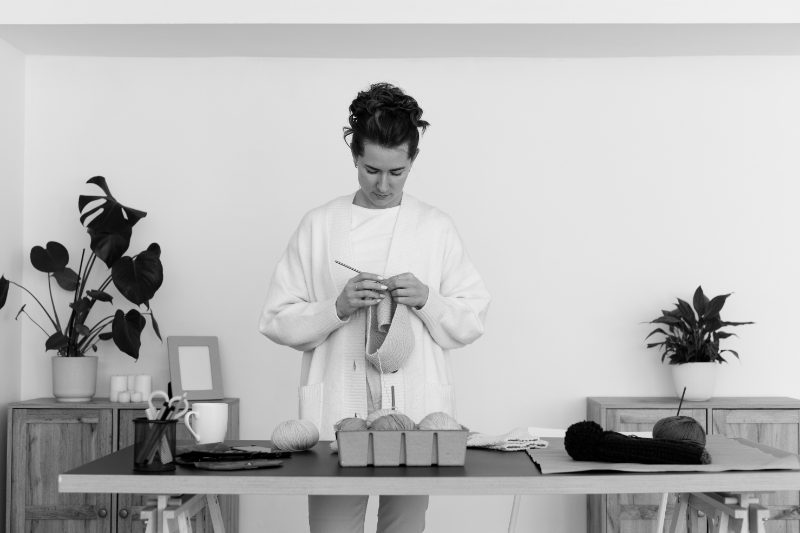Everyone deserves a comfortable home environment, and those with mental health conditions shouldn’t be exempted. It’s even more important for them since they are more prone to being affected by their surroundings.
Specifically, people with Obsessive Compulsive Disorder (OCD) should take more care of their surroundings. Due to their condition, they often use repetitive cleaning as a coping mechanism, even when their living spaces are already clean. It can hinder how they interact with more pressing and important tasks.
You may already know that psychological intervention is the surest way to help people with OCD. However, practical organization efforts can also help ensure a functional environment. This is where the concept of minimalism comes into play.
This article will discuss minimalist principles, and how they can address clutter to create functional living spaces for people with OCD. It will also discuss the practices that people with OCD or their support systems can do. The sections below contain many tips to help families create a functional living space everyone deserves. And it can start with you. Find out more!
Understanding the challenges of OCD in living spaces
Imagine visiting a friend’s house to hang out, and you notice that their snack jars are precisely arranged by color and shape. Your friend gets irritated when you accidentally drop a snack crumb on the couch, even if it is just a small crumb. Not only that! Your friend also asks you to return the jars when you finish snacking, as precise as how they served you.
More or less, that’s what OCD sufferers do. They will be very disturbed by the slightest distraction in their surroundings. It can come to a point that it will harm their relationship with themselves and those around them.
Thus, this section will take you to delve deeper to understand the effect of ‘disorganization’ on people with OCD and how it becomes an enemy for them.
The relationship between OCD and ‘disorganization’
OCD is a disorder commonly associated with anxiety. The anxiety encourages recurring, unwanted thoughts (obsession) that make people infatuated with certain things.
People with OCD will then feel compelled to do things repetitively and excessively to find relief (compulsion). These compulsions badly affect how people with OCD function because they will forget other aspects of their lives in pursuit of relief.
In the context of home organization, a certain portion of people with OCD will sometimes struggle with “disorganization.” This results in people with OCD often being stigmatized as neat-freaks.” However, it’s actually rooted in the fear of contamination and/or the desire for orderliness.
The compulsions to relieve this disorganization can take time, often hours, only to get them ‘just right.’ A study suggests that feeling that something is “not right” or “off” is the big factor behind the compulsion to clean.
This can badly affect other life aspects of the people living with OCD — hence the importance of addressing this through professional intervention like Cognitive Behavioral Therapy (CBT).
How order and structure create functional living spaces
Studies have shown that obsessions in the context of OCD can be divided into two classifications, namely autogenous and reactive obsessions. Autogenous is an obsession that comes into mind without clear stimuli, while reactive is an obsession that comes with clear stimuli.
Repetitive cleaning among people with OCD can be explained through the lens of reactive obsessions. Some people with OCD will be easily distracted by small debris or something that is not arranged according to the rules they set, which can trigger the obsessions.
Because clutter is an obvious factor for disorganization, people with OCD will strive to find ways to remedy the situation. This leads to excessive cleaning.
Thus, people with OCD must establish order and structure to feel more comfortable in their living space. This effort can support professional intervention by minimizing the distraction at home.
The benefits of minimalism for people with OCD
On the surface, contemporary minimalism is a decorative technique characterized by simplicity. It uses simple colors, materials, and designs.
Minimalism is portrayed as a lifestyle that encourages simple living — which manifests in less consumption and possessions. People usually start by decluttering, opening up more space in their living environment. The absence of clutter then creates a space that is good for well-being.
In the context of people with OCD, adopting minimalism can at least limit their belongings, which means less time spent to get everything ‘just right.’
Moreover, a minimalist lifestyle is also good for well-being, offering various mental benefits. It helps you manage your space better. It also promotes mental clarity, as less material possessions reduce the burden of decision-making.
Finally, minimalism also fosters more positive emotions, mainly through a sense of joy and peacefulness.
Therefore, while not directly addressing the psychological part of OCD, adopting minimalism for functional living at least improves a person’s well-being.
Read More: Less is More: How Minimalism Transforms Home Organization
Practical tips to help create functional living spaces for people with OCD
It is important to tailor home organization efforts to fit the needs of people with OCD. Creating a functional living space requires a delicate touch to improve, rather than hinder, their daily activities.
This section will discuss actionable things that help with OCD. Both the affected individual and their support system can implement these practices.
Declutter in small steps
Decluttering can be a good start for creating a functional living space for people with OCD. However, you must declutter mindfully so people with OCD will not fall into decluttering compulsively. Here are the tips:
- Start small and specific. Be sure to choose one area to focus on. For example, a single drawer, a shelf, or a cabinet. Keeping it slow can help tasks become manageable, which builds momentum.
- Empty the space. Always start by emptying and pulling everything out of the space. Once empty, clean the surfaces inside.
- No room for maybes. Make sure you always choose between keeping or letting go. Do not postpone the decision. Postponing can distract you from doing other things in the future.
- Be logical. Avoid emotion when choosing what to keep. Focus on the practical side of the items first (e.g., Do you use the item every day?) and then proceed with the sentimental items later.
- Group items accordingly. Always group items together. For example, you can group pens, keys, or kitchen utensils. This can help keep everything looking ‘just right.’
- Setting time limits. Try to do it every Wednesday for 2 hours, for example. This way, you can be consistent while also preventing yourself from compulsive decluttering or, worse – not pushing through with it at all.
Read More: Stop Procrastinating, Start Decluttering
Maintain a regular cleaning schedule
After decluttering, adopt and maintain a regular cleaning schedule. Keeping track of times and routines can help you stay consistent, which minimizes compulsive cleaning. Here are some tips:
- Set clear goals. Again, start small. Always begin with a manageable cleaning project, like doing only a certain part of the house, and then regularly expand each day.
- Set a timer. Similar to decluttering, allocate a time frame for cleaning and always stop when the time’s up. Even if it means that the job is ‘not perfect.’
- Avoid over-cleaning. Always remind yourself not to come back to the same spot. This will prevent repetition.
- Practice self-compassion. Remember to tell yourself that ‘it is okay if it is not perfect.’ Reward yourself with small treats for every small progress.
This practice is important for preventing all the clutter from creeping back in. This will also prevent you from being distracted by impulsive decisions because the schedule creates a timeframe.
Adopt timeless features
Becoming a minimalist means being sustainable. To be sustainable, you must adopt timeless living space features. This will help ease your mind whenever you have to change furniture. Here are the tips:
- Quality over quantity. Always prioritize high-quality items that can last longer in your space.
- Neutral color and natural materials. Choose neutral colors like white, beige, and gray, along with natural materials like wood or stone. These can prevent distractions through their calming nature.
- Patterns. Maintain simplicity using minimal patterns (i.e., stripes in a rug or cushion), which are less likely to feel chaotic and distracting.
- Multifunctional furniture. Choose furniture with built-in storage (i.e., ottomans or side tables with compartments) to house small items and visually create minimal clutter.
Adopting a timeless design can simplify your space. This will further prevent distraction and overload by unnecessary patterns, colors, and items — making it easier to navigate your daily activities.
Shop with intention
Home organization must be accompanied by responsible consumption behavior. Minimalism encourages ‘putting the money where your mouth is’ to align your spending habits with what really matters. This behavior will eventually lead to less clutter and less distraction at home. Here’s how you can do that:
- Adopt a minimalist mindset. Always try to focus on the purpose of the items instead of the temporary satisfaction of buying them.
- Ask key questions. Before purchasing, ask yourself questions such as “Do I truly need this item?” or “Do I already have something similar?” You can finally buy the item after you are confident that the answer to these questions is “Yes.”
- Stick to your list. Be mindful of what you initially intended to purchase. If an item is not on the list, do not buy it.
- One-in-one-out rule. For every new item you purchase, declutter existing items. This can prevent you from having two similar items at one time.
Shopping with intention can create a sense of purpose. Doing this practice allows you to filter which items are important to you before they clutter your surroundings.
Read more: Improve Your Home With Conscious Consumerism
In conclusion
People with OCD face a condition that compels them to do things repetitively. This condition can badly affect other aspects of their life because they focus more on infatuation while neglecting other essential matters.
Imagine if this happens to you or your loved ones. Even though your house is spotless, you always feel irritated by a bit of dust. So, you’ll forget your other responsibilities just to keep your home “always clean.”
Of course, getting professional psychological treatment is a must, but you should still practice in-home organization techniques to approach the issue.
This article helped you understand the impact of OCD and how minimalist principles can help create functional living spaces. Mindful minimalism could ease the obsession of keeping everything always clean and neat. So, start improving your life, one room at a time!
If you would like to see more resources on organizing for OCD, check out the Home Organization Science Labs. The lab uses the research of the Institute for Life Management Science to produce courses, certifications, podcasts, videos, and other tools. Visit the Home Organization Science Labs today.
Photo by Freepik


